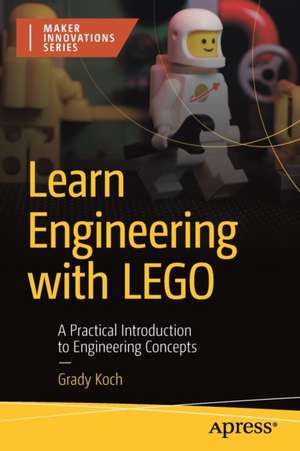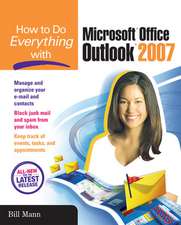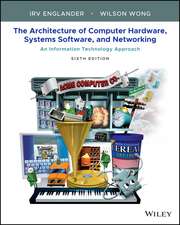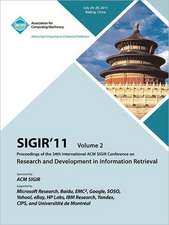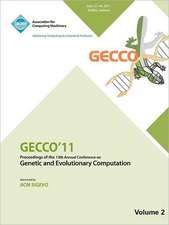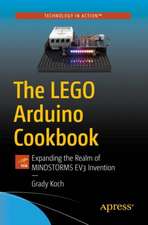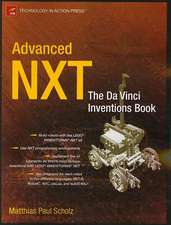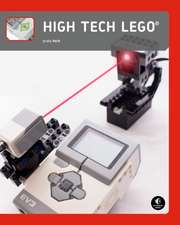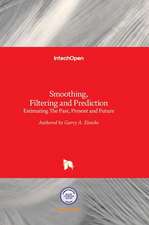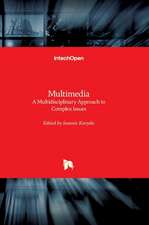Learn Engineering with LEGO: A Practical Introduction to Engineering Concepts: Maker Innovations Series
Autor Grady Kochen Limba Engleză Paperback – 4 mai 2023
This book is a hands-on tour of how machines work with LEGO—there’s nothing like building a machine with your own two hands to understand how it works. It includes aspects of software engineering, mechanical engineering, and electrical engineering. As parts and associated engineering concepts are presented, they will be shown in their practical use with graphical step-by-step assembly instructions.
The concepts conveyed are mostly learned through building examples, with text explanation to reinforce the ideas being learned. Every engineering concept has a building example to go with it, in a quick build of less than 15 assembly steps. At the end of each chapter there’s a project to tie the concepts of the chapter together of a little more complexity, involving 15 to 30 steps. These assembly steps are drawn with a computer aided design program that looks like the diagrams that LEGO produces for its products, so readers will be familiar with the look of the assembly directions.
What You'll Learn
- Layout a Word Blocks or Python computer program from scratch
- See how LEGO building elements are meant to be assembled
- Manipulate the power source of a rotating shaft from an electric motor
- Use gears to alter the speed and torque of a power train
- Change the motion from a rotating shaft to a desired action Basic mechanisms (turntable, differential, cam, ratchet, etc.) to
- Use sensors (motion, distance, light, color) to make interactive inventions
- Integrate mechanical, software, and electrical subsystems in a project
The knowledge presumed in this book is basic familiarity in building with LEGO, having past experience with building a set of moderate complexity of more than a 100 pieces. Basic familiarity with operating a personal computer is also assumed, such as to install an app.
Likely interested readers are: LEGO fans looking for ways to build new and better inventions, middle-school and high-school age students who have an interest in science, math, and engineering, adults who like to learn how things work and tinker with inventions, and educators who use the SPIKE Prime set and are looking for new ideas for lesson plans.
Din seria Maker Innovations Series
- 20%
 Preț: 280.54 lei
Preț: 280.54 lei - 20%
 Preț: 255.82 lei
Preț: 255.82 lei - 20%
 Preț: 321.29 lei
Preț: 321.29 lei - 20%
 Preț: 336.99 lei
Preț: 336.99 lei - 20%
 Preț: 181.89 lei
Preț: 181.89 lei -
 Preț: 277.11 lei
Preț: 277.11 lei - 20%
 Preț: 279.03 lei
Preț: 279.03 lei - 20%
 Preț: 328.97 lei
Preț: 328.97 lei - 20%
 Preț: 230.98 lei
Preț: 230.98 lei - 20%
 Preț: 239.56 lei
Preț: 239.56 lei - 20%
 Preț: 274.18 lei
Preț: 274.18 lei - 20%
 Preț: 321.66 lei
Preț: 321.66 lei - 20%
 Preț: 265.39 lei
Preț: 265.39 lei - 20%
 Preț: 239.19 lei
Preț: 239.19 lei - 20%
 Preț: 262.59 lei
Preț: 262.59 lei - 20%
 Preț: 210.59 lei
Preț: 210.59 lei - 20%
 Preț: 272.48 lei
Preț: 272.48 lei - 20%
 Preț: 293.61 lei
Preț: 293.61 lei -
 Preț: 317.81 lei
Preț: 317.81 lei - 20%
 Preț: 255.82 lei
Preț: 255.82 lei - 20%
 Preț: 342.14 lei
Preț: 342.14 lei - 20%
 Preț: 239.76 lei
Preț: 239.76 lei - 20%
 Preț: 216.20 lei
Preț: 216.20 lei - 20%
 Preț: 255.45 lei
Preț: 255.45 lei - 20%
 Preț: 240.14 lei
Preț: 240.14 lei - 20%
 Preț: 306.71 lei
Preț: 306.71 lei - 20%
 Preț: 335.18 lei
Preț: 335.18 lei -
 Preț: 436.96 lei
Preț: 436.96 lei - 20%
 Preț: 362.62 lei
Preț: 362.62 lei - 20%
 Preț: 229.72 lei
Preț: 229.72 lei
Preț: 265.92 lei
Preț vechi: 332.40 lei
-20% Nou
Puncte Express: 399
Preț estimativ în valută:
50.89€ • 52.93$ • 42.01£
50.89€ • 52.93$ • 42.01£
Carte disponibilă
Livrare economică 25 martie-08 aprilie
Preluare comenzi: 021 569.72.76
Specificații
ISBN-13: 9781484292822
ISBN-10: 1484292820
Ilustrații: XX, 418 p. 482 illus., 481 illus. in color.
Dimensiuni: 155 x 235 mm
Greutate: 0.61 kg
Ediția:First Edition
Editura: Apress
Colecția Apress
Seria Maker Innovations Series
Locul publicării:Berkeley, CA, United States
ISBN-10: 1484292820
Ilustrații: XX, 418 p. 482 illus., 481 illus. in color.
Dimensiuni: 155 x 235 mm
Greutate: 0.61 kg
Ediția:First Edition
Editura: Apress
Colecția Apress
Seria Maker Innovations Series
Locul publicării:Berkeley, CA, United States
Cuprins
Chapter 1: The Hub.- Chapter 2: Programming.- Chapter 3: Building Elements.- Chapter 4: Gears.- Chapter 5: Mechanisms.- Chapter 6: Motors.- Chapter 7: The Motion Sensor.- Chapter 8: The Distance Sensor.- Chapter 9: The Color Sensor.- Appendix A: Parts List.
Notă biografică
Grady Koch is the author of several books about LEGO and the founder of the website hightechlego.com. He has a Ph.D. in Electrical Engineering and 35 years of experience as a research engineer at NASA Langley Research Center, where he has built optical and laser instruments that have been flown on aircraft and orbited the Earth. He has three patents in the field of lidar for studying the atmosphere and is the author or contributor of over 200 journal and conference publications. Throughout his career, Dr. Koch has mentored many interns and found that students sometimes need a little help in making the transition of what they’ve learned in classroom to real-world practice. These ideas of applying knowledge to practice are incorporated into his LEGO books.
Textul de pe ultima copertă
LEGO Mindstorms and SPIKE Prime are great products with vast capabilities, but are often so complex that many people don't know how to use them. LEGO provides a walk-through of a few projects to build, which are cool, but after building these many people get stuck on "now what?" This book answers that question by showing the underlying principles required to build their own ideas.
This book is a hands-on tour of how machines work with LEGO-there's nothing like building a machine with your own two hands to understand how it works. It includes aspects of software engineering, mechanical engineering, and electrical engineering. As parts and associated engineering concepts are presented, they will be shown in their practical use with graphical step-by-step assembly instructions.
The concepts conveyed are mostly learned through building examples, with text explanation to reinforce the ideas being learned. Every engineering concept has a building example to go with it, in a quick build of less than 15 assembly steps. At the end of each chapter there's a project to tie the concepts of the chapter together of a little more complexity, involving 15 to 30 steps. These assembly steps are drawn with a computer aided design program that looks like the diagrams that LEGO produces for its products, so readers will be familiar with the look of the assembly directions.
What You Will Learn •
How to layout a Word Blocks or Python computer program from scratch
• How LEGO building elements are meant to be assembled
• How to manipulate the power source of a rotating shaft from an electric motor • How gears manipulate the speed and torque of a power train
• Basic mechanisms (turntable, differential, cam, ratchet, etc.) to change the motion from a rotating shaft to a desired action a quick build of less than 15 assembly steps. At the end of each chapter there’s a project to tie the concepts of thechapter together of a little more complexity, involving 15 to 30 steps. These assembly steps are drawn with a computer aided design program that looks like the diagrams that LEGO produces for its products, so readers will be familiar with the look of the assembly directions.
Caracteristici
Understand the basic principles and become empowered to invent your own designs Gain a new understanding of how to solve problems in your own building endeavors Learn software, mechanical, and electrical engineering principles, and how these sub-disciplines work together
